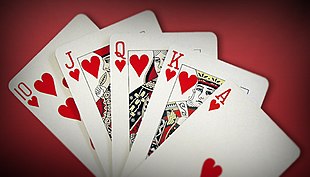Royal Holdem
Between two Royal flushes, there can be no tie breaker. If two players have Royal Flushes, they split the pot. The odds of this happening though are very rare and almost impossible in texas holdem because the board requires three cards of one suit for anyone to have a flush in that suit.
A situation where where a player with two high cards (e.g. Ace-Queen) is all-in preflop against another player with a lower pair (e.g. Jacks) is called a coin flip. Each player has roughly a 50% chance of winning the hand. In most cases is the pair the slight favourite to win the showdown. Updated March 08, 2017 If you've ever played poker, you know that each hand has a name, such as a flush, for five cards of the same suit. A royal flush is the best hand in regular poker: making a straight-flush with the royal family (Ace-King-Queen-Jack-Ten) of one suit. Those names have been around for centuries.
Royal Hold’em Tips & Tricks
Playing Royal Hold’em can be a lot of fun. Not only do you consistently see big, exciting hands, it’s easy to learn because the rules are so familiar to Texas Hold’em. However, don’t fall into a trap of playing in less than ideal situations. Read this guide to find out how to get your start.
Royal Hold’em appeals to the math-conscious Hold’em player. There are frequent opportunities where pot odds and counting outs are relevant to your decision-making process.
There are a few key differences between Royal Hold’em and its Texas counterpart. The game is played at a 6-max table only, and uses just 20 cards (a stripped deck of tens, jacks, queens, kings and aces only). This means short-handed pots are the norm, and being aware of position during a hand is highly important.
It’s easy to get carried away with strong hands in Royal Hold’em, but playing them out will give you some insight into correctly folding ‘second best’ hands and not leaking chips into pots you should avoid.
Pre-Flop Hand Selection
Hand selection is key. Because Royal pots are usually won by the best possible hand (or close to it), you should only consider playing premium hands like AA or KK. Even AK is vulnerable when you flop top pair only. Depending on your opponents, chip stacks, and whether you are in a ring game or tournament, you should nearly always raise with AA or KK. With AA, you can even re-raise to try to maximize your profit.
Raising in position pre-flop, particularly from the Button, with hands other than AA of KK is fine if everyone else has folded, especially if you perceive the players in the blinds as tight. But be careful — extending your raising range too much when there are limpers, or if there’s a chance to get multiple callers is asking for trouble. Still, you can include QQ or AK in your raises to keep your opponents guessing. Just remember that calling pre-flop with these weaker hands requires the ability to recognize unfavorable post-flop scenarios and minimize losses by folding ‘trappy’ hands.
Position is important because you want to have control of the betting. Think ahead. Raising in the Under the Gun seat with a poor hand will likely put you in an awkward situation later in the hand.
Post-Flop

Be wary of any hand after the flop which is not either the nuts, or drawing to a hand that will beat the current nuts. Straights are actually very weak hands in Royal Hold’em. Against three of a kind, a straight with no royal flush draw can only ever get a split pot (when the board fills in a Broadway straight to give a straight for everyone).
Texas Holdem Royal Flush Odds
Counting outs and calculating pot odds is an important part of Royal Poker when considering calling post-flop bets. Awareness of your opponents’ tendencies will give you an idea of their hand strength, and then you can decide if your hand is already strong enough or has enough potential to stick around.
A flush draw is always drawing to a royal flush and is sometimes quite playable. Since the game only uses 20 cards, the chance of hitting a one-card out is better than 1 in 7 if you’re facing a small bet on the flop.
General Strategy
ABC poker will work against bad players. Patience will reap rewards against overly-aggressive players. With the probability to get AA being better than 1 in 32, you will rarely go for long without some exciting action pots.
Making correctly-sized bets and raising when you should will help you extract value from calling hands when you think you currently have the best hand. In Royal, your hand strength is much more readable than with a full deck, and observant opponents will be using their analysis and counting their outs, too. Don’t let them make good value calls by being too passive.
Bluffing is possible against opponents who are playing too tight or those who perceive you to be tight. This can lead to some interesting blind vs. blind battles, so it pays to tune up on your Heads Up play. And don’t forget to make some player notes!
Royal Hold'em
Ready to take your seat? Before you join a game, be sure to check out this forum post where Replay’s Royal Hold’em aficionados offer their own advice!